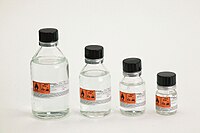
Photo from wikipedia
Abstract In order to develop anion exchange membranes (AEMs) with high ionic conductivity, low swelling ratio (SR) and long-term alkaline stability, a series of crosslinked polybenzimidazole-based AEMs (FPBI-QPVCx) were prepared.… Click to show full abstract
Abstract In order to develop anion exchange membranes (AEMs) with high ionic conductivity, low swelling ratio (SR) and long-term alkaline stability, a series of crosslinked polybenzimidazole-based AEMs (FPBI-QPVCx) were prepared. We herein demonstrated that the integration of a partially fluorinated polybenzimidazole and quaternized poly(vinylbenzyl chloride) benefits the fabrication of the AEMs with well-defined hydrophilic/hydrophobic phase-segregated structure, leading to a relative high hydroxide conductivity of 91.7 mS cm−1 at 80 °C for FPBI-QPVC2.5. The existence of a crosslinking structure endowed the as-prepared AEMs with relatively low water uptake and SR. Besides, the FPBI-QPVCx AEMs also have robust mechanical properties, high thermal decomposition temperature and good alkaline stability. Only 10.7% of conductivity loss was observed after soaking the ether-bond-free AEMs into 1 M a.q. KOH at 80 °C for 480 h. A maximum power density of 197.5 mW cm−2 was determined by a single cell using FPBI-QPVC2.5 AEM.
Journal Title: Journal of Membrane Science
Year Published: 2019
Link to full text (if available)
Share on Social Media: Sign Up to like & get
recommendations!